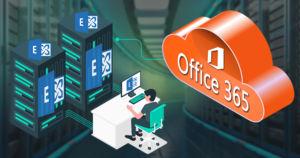Despite being the advanced and latest technology, Exchange 2019 is not fully secured from data loss. Various reasons can be responsible for Exchange data loss. In the condition of accidental deletion as well as EDB corruption scenarios, data loss can happen. In case of accidental deletion, deleted files remain preserved for the retention period. Retention period is of 30 days. After the completion of the exchange retention period, the deleted mailbox gets permanently removed. Let’s know about the way to recover Exchange Server 2019 mailboxes.
Recover Exchange Server 2019 Mailboxes after Deletion
“Connect a mailbox” is an option in Exchange Admin Centre. Using this option users can restore the Exchange mailboxes. Follow the below-given steps:
- Firstly, Move to the Recipients. Click on the Mailboxes in Exchange Admin Centre. Click on the more.
- Now, make a click on connect a mailbox.
- Here the list of disconnected mailboxes will appear. Here, select the mailboxes that you want to restore. Click the Connect button.
- Now make a click on the “Yes” for confirming the action.
- Here you will see a list of the user Account. Select that you want. Now click on the Ok.
By this, the deleted mailbox gets connected to the user account.
You can also connect the disconnected mailboxes using the Management Shell cmdlet:
Connect-Mailbox-Identity “mailbox name” –Database “Database name”- User “AD user account name”- Alias “Alias name”
However, these manual ways do not guarantee the recovery of inaccessible and corrupted data. There may be several reasons for the inaccessibility of Exchange data. Consequently, chances of Exchange data recovery decreases with a manual method.
What if Manual Way Fails to Recover Exchange 2019 Database?
The manual way has numerous drawbacks and limitations. Hence can’t be trusted for the perfect recovery. To repair EDB files inbuilt utility Eseutil and Isinteg are also used. But like others it also has limitations. The manual way fails to provide a proficient and satisfactory way. Hence need for a tool for the professional solution rises.
To answer the professionals’ needs, Shoviv Exchange Recovery Tool comes with numerous features. This software is dedicatedly built for the recovery of Exchange Database, EDB file issues. Let’s know about the Shoviv Exchange Recovery Tool.
Salient Features of Shoviv Exchange Recovery Manager:
Shoviv Exchange Recovery Manager is an astounding utility for the tasks related to the Exchange recovery. Whether it to recover Exchange Server 2019, Exchange 2016, Exchange 2013, or any other versions. It works for all. Shoviv Exchange Recovery Manager is absolutely suitable to recover Exchange Server 2019 mailboxes. This software is an expert in repairing and recovering EDB files with ease. Some of the highlighted features of this software are:
- It offers absolute and complete recovery of the Exchange Database.
- Swift recovery of the hardly deleted database.
- This software is a master in recovering EDB files and restoring them.
- It is a multi-functional utility. It allows adding EDB file, Exchange Server Mailboxes, Office 365 Mailboxes, Outlook Profile Stores, and Exchange Server as a source.
- Along with recovery, this software has features for migration. Users can also migrate from one Exchange Server to Another.
- It also deals with the migration of Office 365 mailboxes, to and from.
- After recovery users can also save data in the PST, MSG, EML, RTF, HTML et cetera file formats.
- An advanced option of “Incremental Export/Backup in PST files” is also present with the software.
- A free demo version of the Exchange Recovery Manager is also available to download. Users can check it before using it to recover Exchange Server 2019.
Conclusion:
No one wants to remain with inaccessible data but corruption, deletion happens accidentally. To recover Exchange Server 2019 mailboxes, users have two ways. The manual method as well as third party tool. Manual methods as described above, are lengthy, technically tough, and less effective. On the other hand, Shoviv Exchange Recovery (a third-party professional tool) provides quick, effective, and simple processing. It is compatible with all the versions of MS Outlook, Exchange Server, and Windows O.S.
- How to Backup and Restore Emails in Webmail? - March 25, 2025
- How to Migrate Outlook to New Computer? - February 15, 2025
- Fix If Outlook Cannot Display the Specific Folder Location - February 1, 2025




